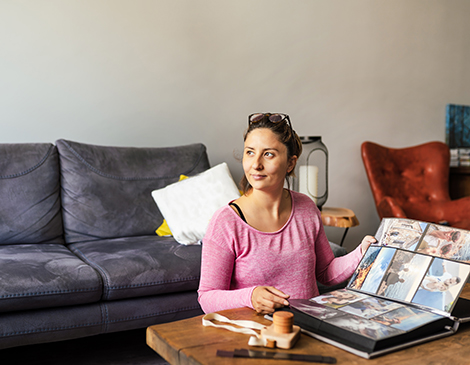Sometimes he flies to the back of the house, taps on the kitchen window and looks me dead in the eye, as if to say, “You listening to this?” His sole mission is capturing my attention.
When I first laid eyes on him, I must have looked like a toddler seeing the candles lit on her birthday cake, a moment of wide-eyed joy. In the next moment, I felt a stab of knee-jerk fear.
My mother grew up with the superstition that a bird trying to enter your house is an omen of death, a piece of information I could have done without, especially now, when death pervades our collective conversation. I decided I wasn’t going there. So now the finch goes by Phillip, and all manner of Phillip pictures have been added to an album of images I call my coronavirus diary.
When my writer’s mind went mute, unable to string sentences together, I discovered that taking mundane photos during these mind-boggling days could build a bridge between my experiences in real time and the words I’m waiting to find. I can easily access the archives of public history, but my pictures document personal history, and the two are inextricably bound.
Oddly, the photos taken as a whole suggest almost nothing about the pandemic. Rather, they seem like an inventory of everything that brings me comfort, at least everything within the confines of home. The only exception are pictures of the office of my husband’s small business. After renting space for many years, we purchased an 1898 parsonage, transforming it into a workplace of light-filled windows and polished wood floors, with plaster walls and high ceilings we hired our son and his friends to paint.
I accompanied my husband there one Sunday just before the stay-at-home order went into place. As he closed up, I felt compelled to take pictures of the entire place, like the videos of all your belongings that insurance companies want in the event of a disaster. “Look at everything you’ve built here,” I said to him. “For your family and others.” It felt important to say. Immersed in the everyday pressures of running a small business, I think he often forgets that part. And suddenly those pressures had accelerated to survival mode.
At home, I harvested a visual catalog of solid, dependable things. The kitchen chalkboard framed with the words “Home is where your story begins.” An overstuffed couch. Blankets airing on the deck railing. My desk, which is always happy to see me, like an ecstatic dog that thinks you’re never coming back. Bookshelves filled with volumes we have loved at every stage of our lives. There are a handful of timely pictures, too. A gas pump showing $1.009 a gallon. My son giving himself a haircut. Grocery lists, the recipes I haven’t made for years, the comfort foods we’ve hungered for. March’s calendar page with everything crossed out.
Lately, though, the relevance of those everyday photos has drained away, replaced by images from Minneapolis: George Floyd, dying under the knee of a police officer in broad daylight.
The unfathomable barbarism of his videotaped murder was as surreal as it was sickening. The world seemed to cry out with one voice: “How? How does this keep happening?”
As a white woman, I know my own grief at this public tragedy can’t possibly approach the bone-deep sorrow and rage felt by his family and every black person in this country. The brutality I saw as unfathomable they recognized too well.
The surge of protesters filling the streets of more than 2,000 American cities hold out the promise that this time is different. They’re forming a forceful coalition, channeling grief and outrage into change. I can join them in more than principle. I can do more.
George Floyd will be remembered as the icon of what might be the tipping point that dismantles systemic racism. But I hope he will be remembered first as a living, breathing human being.
In an old file of hand-scribbled notes I found a quote for which I cannot locate the source: “Write the lives of ordinary people as if you are writing history.” At the heart of George Floyd’s place in history are the day-to-day details of his stolen being. I cannot know George. But I can honor his ordinary, extraordinary life.
I can wonder: What images filled the pages of his days? I know he was called a gentle giant, and that he played basketball in college. What else brought him joy and comfort? What was his favorite song, the food he liked to share with friends? What was his first word, and where did he take his first tentative steps? I wish we all had a picture of the way his face lit up when he held his children. I wish we could have known the sound of his laugh. I wish we could see the faces of everyone he loved.
As if on cue — I am not making this up for effect — I just heard a tapping at my kitchen window. It’s a tiny messenger with feathers, the thing that’s said to carry hope, still waiting for me to pay attention. I am wordless once again. But now it’s time to listen.




